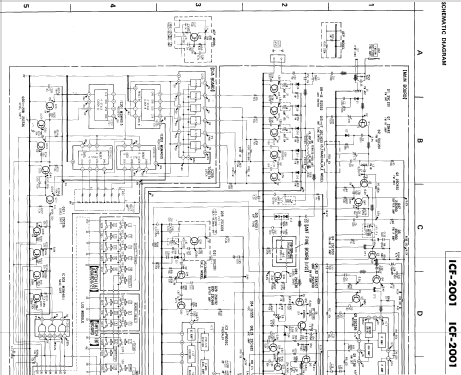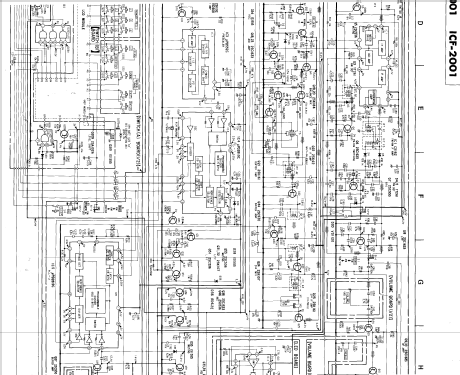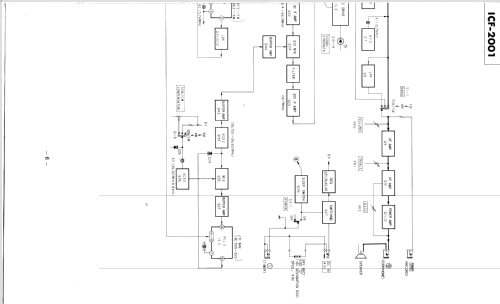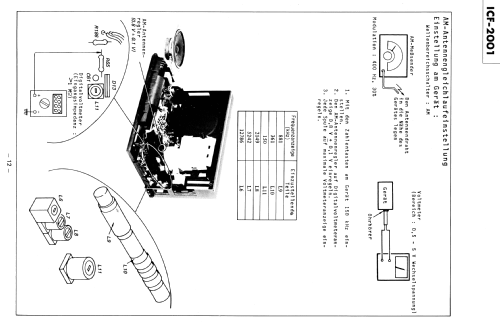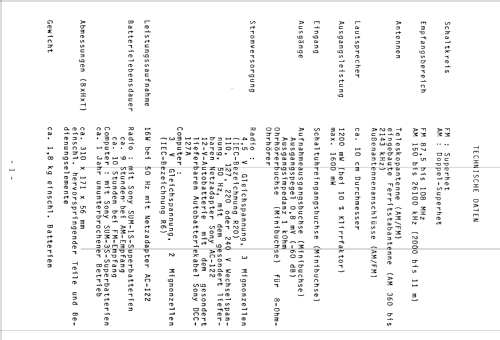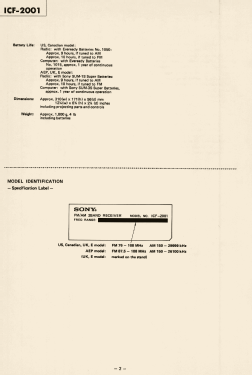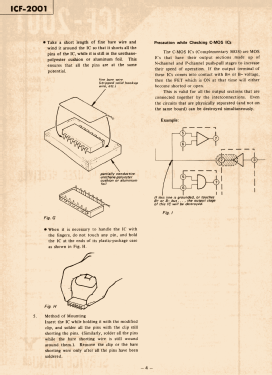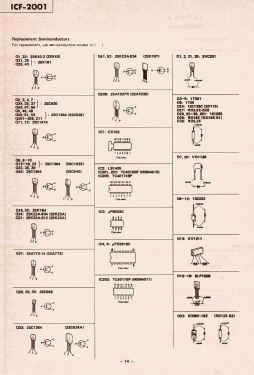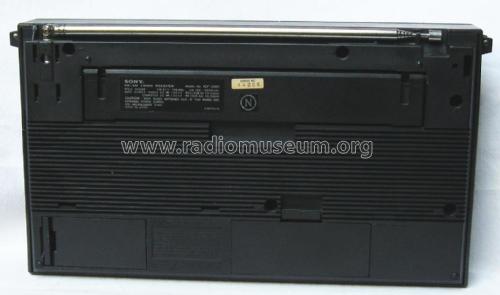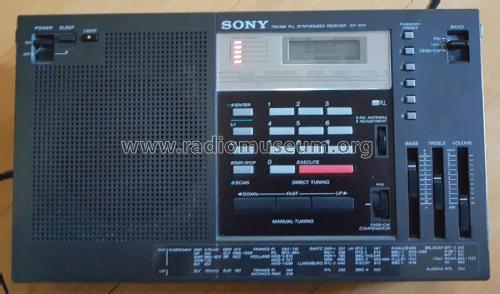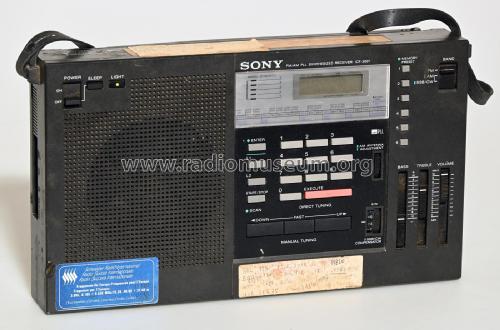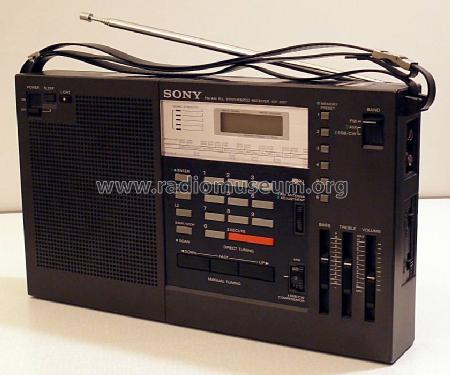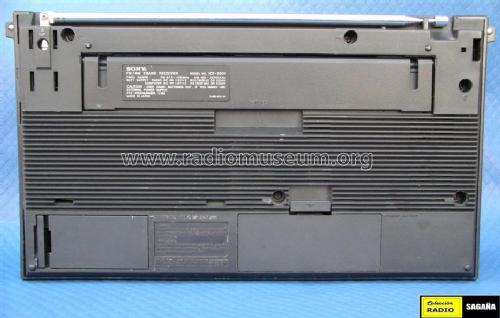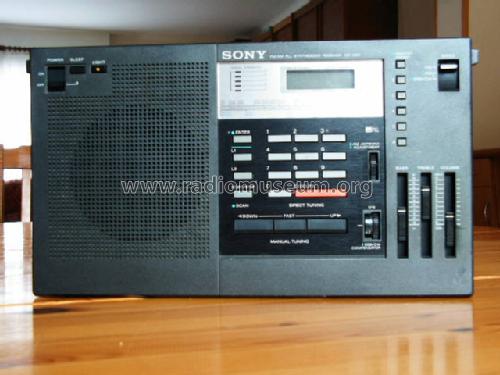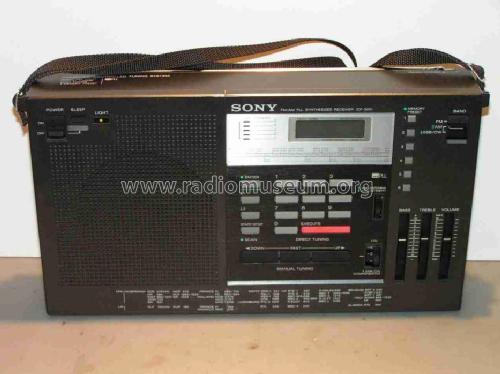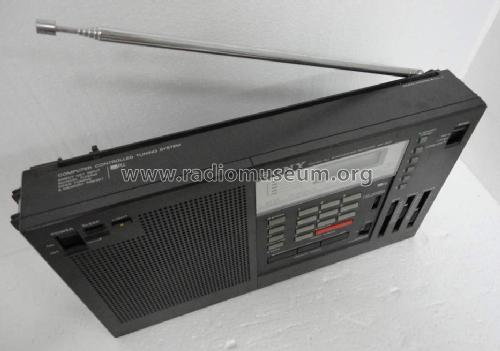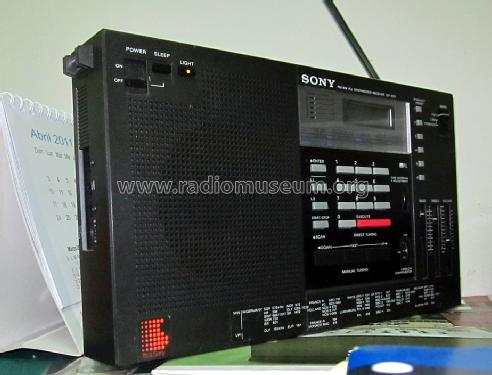FM/AM PLL Synthesized Receiver ICF-2001
Sony Corporation; Tokyo
- Pays
- Japon
- Fabricant / Marque
- Sony Corporation; Tokyo
- Année
- 1980–1983
- Catégorie
- Radio - ou tuner d'après la guerre 1939-45
- Radiomuseum.org ID
- 74809
Cliquez sur la vignette du schéma pour le demander en tant que document gratuit.
- No. de transistors
- 42
- Semi-conducteurs
- Principe général
- Super hétérodyne, conversion double ou triple; FI/IF 66350 kHz
- Gammes d'ondes
- PO, GO, plus que 2 x OC et FM
- Tension / type courant
- Piles sèches / 3×1,5 + 2×1,5 Volt
- Haut-parleur
- HP dynamique à aimant permanent + bobine mobile / Ø 10 cm = 3.9 inch
- Puissance de sortie
- 1.2 W (qualité inconnue)
- Matière
- Plastique moderne (pas de bakélite, ni de catalin)
- De Radiomuseum.org
- Modèle: FM/AM PLL Synthesized Receiver ICF-2001 - Sony Corporation; Tokyo
- Forme
- Portative > 20 cm (sans nécessité secteur)
- Dimensions (LHP)
- 310 x 171 x 56 mm / 12.2 x 6.7 x 2.2 inch
- Remarques
-
Covers 150 - 29999 kHz, German version 150-26100 kHz; digital readout,
frequency keypad, 6 memories; AM, SSB (BFO), FM(VHF).Matching Power Adapter Sony AC-122.
- Poids net
- 1.8 kg / 3 lb 15.4 oz (3.965 lb)
- Source extérieure
- R. Lichte
- Littérature
- Funkschau (Heft 7/März 1981 Seite 77 ff Gebrauchstest)
- Auteur
- Modèle crée par Martin Bösch. Voir les propositions de modification pour les contributeurs supplémentaires.
- D'autres Modèles
-
Vous pourrez trouver sous ce lien 4068 modèles d'appareils, 3925 avec des images et 975 avec des schémas.
Tous les appareils de Sony Corporation; Tokyo
Collections
Le modèle FM/AM PLL Synthesized Receiver fait partie des collections des membres suivants.
- Ernst Erb (CH)
- Karlheinz Fischer (D)
- Salvador Galan-Ocaña (E)
- Michael Gnaedig-Fischer (MEX)
- René Goebel † 21.12.23 (D)
- Ottmar Lauth (D)
- Thomas Loidl (A)
- Francisco Martins (P)
- Fred Nerger (D)
- Johann Nussbaum (D)
- Enrique Palacio (RA)
- Jorge Eduardo Pinto-Cubillas (PE)
- Jacques-André Ramelet (CH)
- Ignacio Rodriguez-Rodriguez (E)
- Franz Sattler (A)
- Peter Seifert (D)
- Sándor Selyem-Tóth (H)
- Gil Silva (P)
- Holger Struthoff (D)
Littérature
Le modèle FM/AM PLL Synthesized Receiver est documenté dans la littérature suivante.
Contributions du forum pour ce modèle: Sony Corporation;: FM/AM PLL Synthesized Receiver ICF-2001
Discussions: 4 | Publications: 9
There are plenty of reports publicly available concerning recurrent issues with the 3V battery system powering the D/A Board.
Symptoms include failure to power ON, blank LCD, random resets and total lockouts requiring to remove and reinsert the two 1.5V dry cells to recover.
I acquired two of these radios, and I am getting courage to dismantle them piece by piece for inspection and further testing.
One of them is in need of a loudspeaker replacement, because when I was opening the cabinet, I had to force the speaker a little to be able to move it away from the front panel while removing the front panel from the chassis.
You know, the speaker is maintained attached to the chassis with one screw that no one can reach before separating the front panel.
It turned out the speaker was glued (!) to the front panel. Really strongly glued. So the paper cone was pulled and torn at one side. Nice start of mine. I should've known better, as I saw this approach on other models.
But I am digressing. Back to the subject.
After looking into the schematics, I was surprised to learn that Sony believed that common spring loaded battery terminals, prone to oxidation leading to potential power interruption due to voltage bouncing due to sound vibration or human operation resulting in digital circuits failing to work properly, was not a point of failure in the design.
I was expecting to see a large capacitor in parallel with the 3V battery supply as a minimum power backup protection against voltage fluctuation due to mechanical vibrations affecting the battery contacts.
But no, there is only a tiny small bypass capacitor C208 0.022uF.
Sony states a current consumption of 75uA from the 3V batteries. Consumers are IC203 CMOS 4011 NAND gates and the so called LCD/Control Module.
Granted, one does not know what is inside this LCD/Control Module as it is not documented as far as I know. Maybe there is a large capacitor or backup battery inside, who knows. If this is the case, it must be defective after all these years.
Even if there is a filter component inside the LCD/Control Module and is not defective, the IC 203 CMOS NAND gates are far away from that filter and therefore are not properly protected against battery voltage bouncing.
Anyway, assuming 2VDC as a minimum to maintain the MOS 4011 and LCD/Control Module processor running, the small bypass capacitor C208 with just 0.022uF. over a load of 40KOHM (calculated as 3VDC / 75uA) would result in a time constant of just 88uS and reach the 2V minimum threshold level in just 36uS.
36 micro seconds.Basically there is no debouncing of intermittent, random, battery contact failures caused by sound pressure from the speaker or when moving or operating the radio.
Even if there is a filter component inside the LCD/Control Module, I see this as a design weak spot.
Fortunately the solution to this issue is quite simple. Just add a small electrolytic capacitor, something like 100uF to have 1.6 seconds until reach the threshold voltage which is much more than enough to filter random voltage drops due to bouncing, or else a 2200uF cap to have 35 seconds running time, enough to replace dead batteries.

Jose Mesquita, 13.Sep.22
Hallo, nachdem ich die Berichte der Sammler aus dem Jahre 2006 las, lasse ich nun die Finger von dem Gerät. Es nerft total, wenn man das liest und nun selbst "durchmacht". Schade drum, aber es gibt eine Grenze der Geduld. W.H.
Wilfried Haack, 04.Mar.21
ICF-2001 Umrüstung auf 10 m Band
Gemäß Leserbrief aus Funkschau Heft 13/ Juni 1981 Seite 6 ist die Umrüstung wie folgt vorzunehmen:
- Drahtbrücke F-C auf der D/A Platine auftrennen
- Draht von F dieser Platine (führt keine HF) an der freien Punkt des Schalters S1-4 (band Switch) legen.
Wolfgang Scheida, 08.Jul.08
ich habe dieses Gerät vor ca. 4 Monaten günstig bei ebay ersteigert. Der Verkäufer wies mich daraufhin , dass etwas mit dem PLL nicht in Ordnung sei. Nach Öffnen des Gerätes stellte ich fest , dass die eh viel zu kurz bemessene Verdrahtung von der Processsorplatine zur Empfangseinheitsplatine teilweise aus der Klemmverbindung herausgerutscht war. Hier werden die nackten Drahtenden einfach in einen Sockel gesteckt. Umso schwieriger ist es diese bei einem Front/Rückseitenabstand von max. 4cm (ab da erst bekommt man die Kabel in den Sockel)wieder gerade in den Sockel zu bekommen.
Jedenfalls lief das Gerät danach; dachte ich jedenfalls.
Gestern wollte ich dieses Radio meiner Frau als Küchenradio zur Verfügung stellen( viele klare Sender,durchaus akzeptable Klangqualität ).
Heute nach dem ich von der Arbeit wieder zuhause war, teilte mir meine Frau mit,dass das Gerät nur ca. 5 Minuten gelaufen sei und dann keinen Mucks mehr tat.
Fehler schnell gefunden : 1 NC-Akku hatte 0 Volt(übrigens der 3.te in 6 Wochen vom gleichen Typ ;sollte das an meinem neuen Ladegerät,auch etwa zu diesem Zeitpunkt gekauft, liegen ?). Habe dann erst mal alle NC-Akkus durch Batterien ersetzt, Gerät eingeschaltet , alles OK,neu programmiert,alles OK und das Gerät in meinem Arbeitszimmer probelaufen lassen.
Dann nach ca. 5 Minuten fällt das Gerät komplett aus. Auch mit Wieder-Ein und Auschalten ist das Gerät nicht zu spielen bereit.Die Displaybeleuchtung funktioniert wie erwartet ,Gerät aus:keine Funktion, Gerät ein: Displaybeleuchtung an; d.h.: da die Displaybeleuchtung von den Empfangsbatterien versorgt werden,wird Strom zum Empfangsteil geliefert.
Nach Entfernen aller Batterien (Processor und Empfangsteil)für ca. 5 Minuten und wiedereinsetzen zeigt das Gerät bei FM 76.0 MHz und bei AM 150 KHz an, also Grundeinstellung. Nach Programmierung spielt das Gerät auch wieder.
Nach ca. 5 Minuten das gleiche wieder. Gerät geht aus (keine Frequenzanzeige mehr).
Alle Batterien für 5 Minuten entfernt, wieder eingesetzt, Gerät läuft wieder, aber mit Grundeinstellung. usw,usw,usw.
Da beim Schütteln des Gerätes irgendetwas in den Batterieräumen geklapppert hat, habe ich die Batterieklappen mit Schaumgummi von innen verkleidet, so dass die Batterien besseren Halt haben.
Seit 1/2 Stunde läuft das Gerät nun.
falls das Gerät morgen immer noch Probleme zeigt, melde ich mich noch mal.
PS:
Das Gerät ist von der elektronischen Konstruktion her sehr komplex (Digitalisierung vereint mit nicht simpler Analogtechnik)
viele Grüße , René Goebel
PS: habe das Gerät gestern bis zum Bettgehen mehrmals ein und ausgeschaltet. Das Gerät lief einwandfrei. Meine Frau berichtete mir d,dass sie das Gerät 3 mal eingeschaltet hat,2 mal nur Rauscheen, 1 mal ganz tot.Heute nach der Arbeit um ca. 16:00 habe ich das Gerät wieder eingeschaltet. Nur Rauschen. Display zeigt auf allen Stationstasten 76 MHz bei FM und 150 KHz bei AM.
Das Gerät geht jedoch wenigstens wieder an und man kann die Sender einstellen,hören und neu programmieren. Beim 5.ten Versuch war das Gerät wieder ganz tot.
René Goebel † 21.12.23, 18.Jan.06
